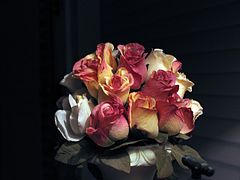|
Nosegay A nosegay, posy, or tussie-mussie is a small flower bouquet. They have existed in some form since at least medieval times, when they were carried or worn around the head or bodice.[1] Doilies are traditionally used to bind the stems in these arrangements. Alternatively, "posy holders", available in a variety of shapes and materials (although often silver), enable the wearing of these arrangements "at the waist, in the hair, or secured with a brooch".[2] The term nosegay arose in fifteenth-century Middle English as a combination of nose and gay (the latter then meaning "ornament"). A nosegay is, thus, an ornament that appeals to the nose or nostril.[3][4] The term tussie-mussie (also tussy-mussy) comes from the reign of Queen Victoria (1837–1901), when the small bouquets became a popular fashion accessory. Typically, tussie-mussies include floral symbolism from the language of flowers, and therefore may be used to send a message to the recipient.[5] In modern times the term specifically refers to small bouquets in a conical metal holder, or the holder itself, particularly when used at a white wedding.[6][7]
See alsoReferences
Wikimedia Commons has media related to Flower bouquets. Look up nosegay in Wiktionary, the free dictionary. |




